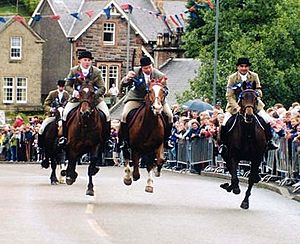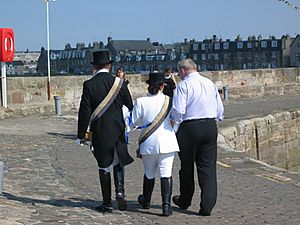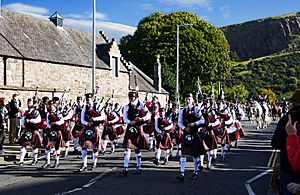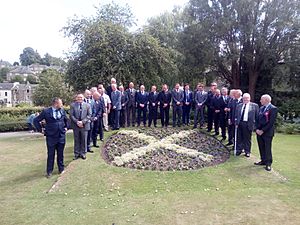Common Riding facts for kids
A common riding is a special horse riding tradition in the Scottish Borders area of Scotland. It's a way for towns to remember their history, especially from the 13th to 15th centuries. Back then, people rode horses to protect their land from raiders called Border Reivers. They also remember a sad defeat for Scotland at the Battle of Flodden.
Today, these common ridings, also called rideouts or riding of the marches, are annual summer festivals. Many towns in the Scottish Borders celebrate them. Each town might have several rideouts during its festival week. Some towns re-enact historical events, while others have their own unique festival rides.
Towns that celebrate common ridings include: Hawick, Selkirk, Langholm, Jedburgh, Coldstream, West Linton, Lanark, Lauder, Edinburgh, Melrose, Musselburgh, Galashiels, Duns, and Peebles.
Contents
History of Common Ridings
The tradition of common riding started a long time ago, in the 13th and 14th centuries. This was a time of frequent wars and raids between Scotland and England, and also between different clans. It was common for families in the Borders to steal cattle, a practice known as "reiving."
In these wild times, local leaders would choose a trusted person from the town. This person would then ride along the town's boundaries, or "marches." Their job was to protect the town's shared land and stop others from taking it.
Even after these rides were no longer needed for protection, people kept the tradition alive. They continued the ridings to remember local stories and history. Today, they are big celebrations filled with parades, singing, and unique horse riding events.
Common Ridings Today
Today, Common Ridings celebrate each Border town's unique history. They happen in mid-summer, from May to September. Hundreds of horses take part in these rideouts. Riders often wear costumes, bringing to life the spirit of the old reivers.
Hawick traditionally kicks off the common riding season. This is because the community famously captured a flag from the English army in 1514. Many towns now hold ridings, including Currie, Penicuik, West Linton, Peebles, Biggar, Galashiels, Musselburgh, Duns, Kelso, Jedburgh, Melrose, Coldstream, Yetholm, Annan, Dumfries, Lockerbie, Kirkcudbright, Wigtown, and Gatehouse of Fleet. The Copshaw Riding in Newcastleton is one of the newest, started in 1998.
Each community begins its celebration by choosing a special leader in the spring. This leader, often called a "principal," is a highly respected figure during the festivities. They usually lead the rideout and visit other towns to show friendship.
Each town often has a different name for its chosen leader:
- Biggar: Cornet
- Penicuik: Hunter (and Hunter's Lass)
- Lanark: Lord Cornet
- Coldstream: Coldstreamer
- Duns: Reiver (and Lass)
- Galashiels: Braw Lad (and Braw Lass)
- Hawick: Cornet
- Jedburgh: Callant
- Kelso: Kelsae Laddie
- Kirk Yetholm, Scottish Borders: Bari Gadgi and Bari Manushi
- Langholm: Cornet
- Linlithgow: Provost of the Deacons' Court
- Melrose: Melrosian
- Peebles: Cornet (and Lass)
- Selkirk: Standard Bearer
- West Linton: Whipman (and Lass)
- Musselburgh: Honest Lad (and Honest Lass)
- Innerleithen: Standard Bearer (and Lass)
- Edinburgh: Captain and Edinburgh Lass
- Annan: Cornet (and Lass)
- Lockerbie: Cornet (and Lass)
- Dumfries: Cornet (and Lass)
- Gatehouse of Fleet: Lad (and Lass)
- Kirkcudbright: Cornet and Lass
- Currie: Ensign
Most community festivals last about a week. Some are shorter, while others can be up to two weeks long. The events include ceremonies, rideouts, entertainment, and traditional Scottish sports. A key part of the celebration is the "bussing" of the Burgh Flag. This colorful ceremony involves tying ribbons to the flagstaff. It's like when a knight's lady would attach a ribbon to his lance before a battle. The ribbon colors usually match the town's colors.
Today, Common Ridings attract huge crowds. Many people who have moved away from the Borders return home for these special events. Tourists from all over the world also come to watch.
Common Riding Festivals
These exciting events happen throughout the summer, starting with Hawick in May and continuing until mid-September.
Hawick Common-Riding
The Hawick Common-Riding is the first and largest of the Border festivals. It celebrates a famous event from 1514 when the community captured an English flag. It also involves checking the boundaries of the town's shared land.
After the Cornet is chosen in May, they lead rideouts every Saturday and Tuesday. These rides visit nearby villages and farms. One special ride goes uphill to "Nipknowes," where they enjoy a traditional snack called "curds and cream."
In 2014, Hawick celebrated its 500th Common Riding, a huge milestone! Women now participate in all activities of the Hawick Common Ridings.
Common Riding Week
On the Sunday before the main Common-Riding in June, the Cornet attends a church service. Later, they visit the Hornshole Memorial to lay a wreath. They also inspect the race-course on the Moor.
On Thursday morning, the Cornet carries the flag for the first time in a big chase. Later, the leaders visit local schools. The Cornet asks for a holiday for the children, which is always granted. Everyone then sings festival songs together.
Colour Bussing
The Colour Bussing ceremony happens on Thursday evening in the Town Hall. The Cornet's Lass carries the flag and "busses" it by tying ribbons to the top of the staff. The flag is then given to the Cornet. They are reminded that the flag represents all the town's traditions. The Cornet is asked to ride the town's boundaries and return the flag "unsullied and unstained" (meaning clean and unharmed).
Friday Mair
Early on Friday morning, the Drum and Fife Band wakes up the town. At 6:00 a.m., a ceremony called "Snuffin'" takes place. Snuff is offered from an old horn by the town's official song singer. People then go to pubs for traditional rum and milk before breakfast. They also sing the "Old Song" outside The Borders Textile Towerhouse.
Then, the Cornet and many riders go around the town. They ride up to the Nipknowes for the main chase. After songs and toasts, they ride to the "marches" (boundaries). The Cornet performs a ceremony called "Cuts the Sod" at the furthest point. They then head to the race-course for horse racing. After the races, a proclamation is made that the boundaries have been ridden without problems. More singing and music follow, and the flag is temporarily returned to the Council Chambers.
Saturday Mair
On Saturday, the town is woken again by the band. The Cornet and riders visit Wilton Lodge Park to lay wreaths at the War Memorial. The procession then goes to the Moor for more horse races.
At 3:00 p.m., the Cornet and riders leave the Moor. They stop at the Coble Pool in the River Teviot to dip the flag. This marks the boundary between Hawick land and an old estate.
When the Cornet returns, their official duties end. They solemnly return the flag to the Provost in the Council Chambers. This is a very important moment, marking the end of the common riding. Riders stand in their stirrups while a band plays, and the Cornet displays the flag one last time. The song "Teribus" is sung many times during the festivities.
Selkirk Common Riding
The Selkirk Common Riding celebrates the history of this old town. It takes place on the second Friday after the first Monday in June. It's one of the oldest ceremonies in the area, with 300–400 riders. Selkirk has one of the largest groups of horses and riders in Europe.
Selkirk still owns shared land north and south of the town. On the day, only the northern boundary is ridden. The Selkirk Common Riding remembers the Battle of Flodden in 1513. Out of eighty men who left Selkirk for the battle, only one, named Fletcher, returned. He carried a captured English flag. Legend says he waved the flag around his head to show that all the other men from Selkirk had been killed. At the end of the day, the town's Standard Bearer and other leaders wave their flags in Selkirk's old Market Place.
Standard Bearer
The Standard Bearer is chosen from young, unmarried men of the town. They usually have helped previous Standard Bearers. They are introduced on Appointment Night, the last Friday in April. They are carried on shoulders around town, with bands and crowds cheering. The Standard Bearer has many duties, including visiting other town common ridings. In 2014, Fiona Deacon became the first female Standard Bearer to carry the Ex-Serviceman's flag.
Common Riding Week
The Saturday before Common Riding Day is the Children's Picnic, with races for primary school kids. Sunday is for inspecting the Rig (the town racecourse) and Show Sunday. Other events include the Standard Bearers Dinner on Monday and Ladies Night on Wednesday. Various concerts and dinners are held for different groups in the town.
Night afore the Morn
On Thursday evening, the Senior Burgh Officer walks through the streets to "Cry the Burley." This announces that the rides will happen the next day. He names the leaders and their helpers. He stops at different places to read the announcement, ending with the old phrase: "There will be all these, and a great many more, and all be ready to start at the sound of the Second Drum."
After this, there's a concert and a special act of remembrance. Former Standard Bearers march to the statue of Fletcher. A wreath is placed, and each former Standard Bearer walks around the statue. Then, people gather in pubs and clubs, renewing old friendships and singing.
Common Riding Day
The day starts very early, at 4:00 a.m. The Selkirk Flute Band marches around town, waking up the Standard Bearer and Provost. At 5:30 a.m., former soldiers hold an Act of Remembrance at the War Memorial.
The "First Drum" sounds at 6:00 a.m. The Silver Band plays around town, leading the singing of "Hail Smiling Morn." The riders gather. At 6:45 a.m., the Standard Bearer is officially installed, and the Royal Burgh Flag is "bussed" on the Victoria Hall balcony. The procession forms and marches to Market Place, waiting for the "Second Drum" at 7:00 a.m. The procession then moves off, with bands, flags, the Standard Bearer, and the mounted riders following.
By 7:30 a.m., the riders cross the River Ettrick and head to Linglie Glen. They reach the top of the Three Brethren cairns, the highest point of the ride. Here, they rest, and the Standard Bearer and helpers sing "Hail Smilin’ Morn."
Back in Selkirk, the foot procession gathers in Market Place and goes to Shawburn Toll for community singing. The riders return at a gallop. The procession re-forms and returns to Market Square for the "Casting of the Colours" ceremony. The Royal Burgh Standard Bearer and others wave their flags to the tune "Up wi’ the Souters." The ex-soldiers' flag is dipped, followed by two minutes of silence for the town's war dead.
The ceremony ends with the Standard Bearer returning the Burgh Flag "unsullied and untarnished" to the Provost. After lunch, there are horse races. The day ends with "The Games," which include gymkhana (horse games) and foot races.
Langholm Common Riding
Langholm's Common Riding, known as "Langholm's Great Day," attracts many people who have moved away from Langholm, as well as tourists. It started from a legal dispute in the 1700s. This dispute made sure that Langholm people had certain rights, like digging peat, within set boundaries. Every year, these boundaries must be re-marked to keep these rights. Over time, this became a big celebration of the town.
Horses are a very important part of the Common Riding. Before the main day, there are "ride-outs" on the hills around the town. On Common Riding Day, the Cornet and their followers must be good riders. They gallop up the Kirk Wynd and reach the Monument as part of checking the old boundaries.
On Common Riding Day, the last Friday in July, after the Cornet receives the flag, there are three "Cryings of the Fair." The Fair Cryer stands on the back of a horse.
Special symbols are also important: the Thistle, Spade, Crown, and Barley Banna'. The "barley banna'" is barley bread nailed to a wooden plate with a salted herring.
The Common Riding Day ends with everyone returning to the Castleholm, singing "Auld Lang Syne." They dance polkas, hand back the flag, and finally sing "God Save The Queen."
Lauder Common Riding
The exact start of common riding in Lauder is unknown, but it is very old.
In Lauder, the boundaries were marked by stone piles called Cairns. The town leaders would ride from cairn to cairn. Newer or younger men would carry stones to add to each cairn. This practice stopped when it was found that their pockets held bottles of drinks instead of stones! The Riding of the Marches was serious business. The date and time were announced by the Town Drummer. If you didn't attend, you could be fined.
The ceremony used to be held on Ascension Day, when the town's lands and crops were blessed. Later, it was held on the King's Birthday. The riders used to race, but this was too dangerous and stopped. The day ended with a dinner.
The practice stopped for about 70 years but was brought back in 1911 to celebrate the Coronation of King George V. It has continued ever since, except during the two World Wars. The modern Common Riding is very similar to the original.
It is not held to remember a battle victory, but it still has a religious side. The "Kirkin’ of the Cornet" is a church service where a blessing is asked for the week's events. The Cornet leads followers around the boundaries of Lauder. They stop for refreshments and a toast to the Queen. They also place a stone on the Burgess Cairn, the only remaining cairn.
In recent times, some historical points like "Tom Waldies bridge" and the Waterin’ Stane have been repaired. The Millennium Cairn was built to remember when Lauder regained its Burgh Charter in 1502.
Jedburgh Callants Festival
The Jethart Callant's Festival started in 1947. The first Callant was a rayon mill worker named Charlie McDonald.
The Jedburgh Callants Festival lasts two weeks. It includes ceremonial rides to important historical places. The most important ride is to Redeswire, near Carter Bar. This was the site of the Raid of the Redeswire in 1575. During this event, the arrival of men from Jedburgh, shouting "Jethart‘s here," turned a defeat into a victory against the English.
The Callant leads the mounted riders to Ferniehirst Castle. They stop for a ceremony at the Capon Tree, a very old tree from the Jed Forest. Then they return to town for a final ceremony at the War Memorial.
Saturday begins with a cannon firing and a race around town. This is followed by the Jedburgh Border Games, which have been held since 1853.
West Linton Whipman Play
Common Ridings in West Linton are led by the Whipman. This is an old Scottish word for a carter or carrier. In 1803, after their annual meeting, the Whipmen Benevolent Society visited local mansions. The rest of the day was spent on sports, called "The Whipman Play." This ceremony has continued since then, only stopping for the two World Wars. It was brought back in 1949.
The Linton Whipman is officially installed on Friday evening and leads a mounted procession through the village. Saturday starts with a ride out. Then, there's a week-long program of sports, competitions, a barbecue, and a bonfire.
Galashiels Braw Lads’ Gathering
The Braw Lads’ Gathering is the annual summer festival for the town of Galashiels. It started in 1930 to celebrate the town's history. It remembers an event in 1337 when men from Gala defeated English soldiers. It also celebrates the marriage in 1503 of King James IV of Scotland to Margaret Tudor of England. The festival also marks the town getting its burgh charter and honors local people who died in World War I.
Every year, a local man and woman are chosen to be the Braw Lad and Braw Lass. They take part in the ceremonies and lead the rideouts. Hundreds of people ride horses through the town and countryside. The main Braw Lads’ Day is on a Saturday. It starts at 8 a.m. when the Braw Lad receives the town flag. They then ride to the "Raid Stane," where the 1337 battle happened.
The riders then cross the River Tweed and stop at Abbotsford House. After that, they ride back to town. The Braw Lass mixes red and white roses, remembering the 1503 marriage. Then, the Laird of Gala and the President of the Gathering exchange a special paper, celebrating the town getting its "Burgh of Barony" charter in 1599. Finally, the group goes to the town's war memorial. As the clock strikes noon, the Braw Lad dips the flag to honor fallen soldiers, and a moment of silence is held.
Edinburgh Riding of the Marches
The Edinburgh Riding of the Marches dates back to 1579. The inspection of the Common Land continued until 1718. In 1946, a special 'Riding of the Marches' was held in Edinburgh to celebrate the end of World War II. Seventy riders took part, and huge crowds greeted them in the Royal Mile.
The modern revival of this event started in 2009 and has become more popular each year.
Every year, shortly after the new year, the process begins to choose the Edinburgh Captain & Lass. These leaders represent Edinburgh at various common rides and town festivals throughout the summer. They also attend city events. In September, they lead the Edinburgh common ride around the city's boundaries. This represents the old "inspection of the common land." Afterward, they ride to the Royal Mile to re-enact Randolph Murray returning from the Battle of Flodden. He carried the Blue Blanket, bringing the sad news that Scotland had been defeated and King James IV had died.
Images for kids









